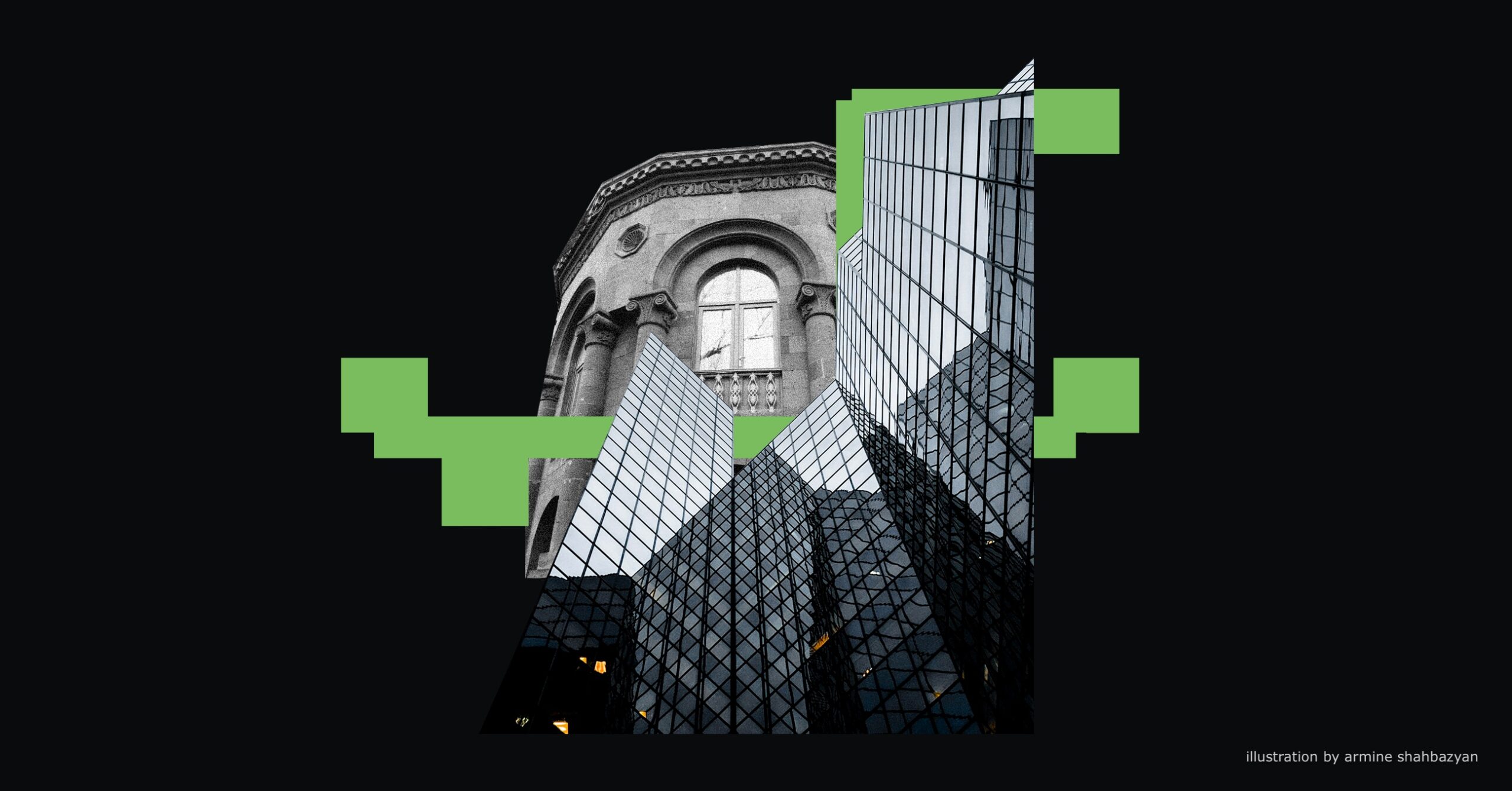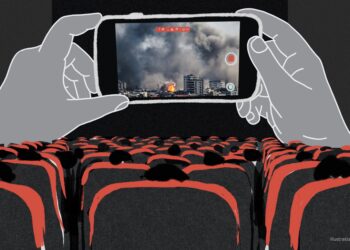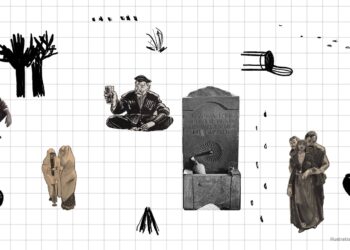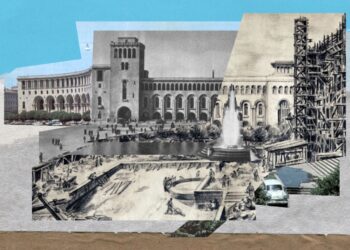
Listen to the article.
It came as a shock. Even staunch government supporters couldn’t quite believe it. What do you mean they are reclaiming the Writers’ Union building? That must be a mistake… But when the turn came for the Artists’ House just a few weeks later in March, the writing on the wall couldn’t have been any clearer. The government had launched a takeover of two sacrosanct, seemingly untouchable institutional relics of the Soviet era — the creative Unions.
The nominal objective of this offensive was the disputed legal ownership of the Unions’ valuable properties. Perched in the heart of Yerevan, on the picturesque Aznavour Square, the Artists’ Union building forms a unified, three-story ensemble with the neo-Renaissance edifice of the legendary Yerevan Hotel. Built by architect Rafayel Israelyan in 1956, it replaced a demolished 18th-century mosque used as an exhibition space in the 1920s by the first pleiad of Soviet Armenian artists. Even more imposing in its grandeur and marble-clad interiors is the Writers’ Union building. A textbook example of 1950s Armenian neoclassical architecture, the palatial complex sits at the beginning of Baghramyan Avenue (a stone’s throw away from the Opera House and the Cascade) and is part of the governmental-institutional axis, for which this street was initially built for. Both Unions also have major resorts in Tsakhkadzor and Sevan, which are also being claimed by the government.
Even without delving into the significant real estate footprint of those sites, the above description should make clear that these are the kind of “flagship” properties to die or kill for. In this instance, the government has decided to potentially send two of the most prominent creative Unions to the guillotine, while others – the architects, the composers, and the cinematographers – are anxiously awaiting in the wings. Indeed, the possible annulment of ownership deeds over these properties would spell the inevitable (if not immediate) demise of these organizations, which have already been shaken to the core following the USSR’s collapse.
The reason given by the General Prosecutor’s Office for initiating legal proceedings is that the buildings have been the property of the State and were passed onto these non-governmental organizations in the early 1990s without due legal proceedings. The Unions retorted that the properties were built through member contributions and, hence, were never technically owned by the State. But the real question is, why has the Armenian government (via the General Prosecutor’s Office) all of a sudden decided to disturb its stable ties with these politically benign institutions, which have traditionally served as the cultural fort posts of the State since their germination in the 1920s?
Though no longer receiving any significant state support since Armenia’s independence in 1991, the Unions continued to toe the official line with all subsequent authorities, who have been more than happy to let these artifacts of the ancièn regime sustain a decorous existence by quietly selling off their substantial assets and idly exploiting the little that was left. There were no visible changes to this set-up even after the 2018 power transition, with Nikol Pashinyan’s government making frequent references to the old intelligentsia and generally cautious not to agitate this army of brush and pen-wielding guardians of the nation’s cultural mores.
Which is why the decision to launch a judicial case against the Unions was so startling. True, the Prosecutor’s Office has recently been taking some steps towards the repossession of state properties that were usurped during the 1990s-2010s in atrociously corrupt, shady deals, thus nominally attempting to fulfill Pashinyan’s 2018 promise that the state would reclaim stolen assets. The recovery of the famous Art Nouveau AOKS building on Abovyan Street last year was presented as a major victory in this regard. But it’s a symbolic achievement against the mass of industrial, agricultural, and cultural assets whose appropriation by Armenia’s past political regimes caused incalculable economic and social damage to the State.
So why not target the greedy oligarchs, most of whom are still comfortably exploiting the fruits of their avarice? Why launch an attack on flailing, calcified, but still functioning cultural platforms, which serve as bastions of conservative tradition? The government has been reticent about the underlying reasons for its judicial claims. During a recent emergency congress with members of the Artists’ Union, the Science, Education, Culture and Sport Minister, Zhanna Andreasyan made broad justifications about clarifying the legal status of the Union’s properties, and “mutual discussions” about their future use.
Yet, the urgency of such legal clarifications is dubious, when other, considerably greater instances of state defrauding are left unbroached. Has the government picked on an easy target whose lucrative real estate assets in the capital and Armenia’s most popular resorts would inject much-needed cash into the state’s coffers? Taking into account the aggressive “optimization” policies of Pashinyan’s cabinet, which is pushing for the monetization of all state properties and institutions — especially cultural ones — that’s a likely scenario. After all, none of these NGOs, or rather their assets, are generating any tangible, hard currency for the state and the possibility of turning these properties into profitable business ventures (with, or without the Unions) is, one would imagine, too tempting. That is exactly how things turned out for the AOKS building. After rumors that it would become an exhibition space for contemporary art or a long-anticipated carpet museum, the government announced on June 5 that it would lease the building to private investors for around 16 million AMD a month.
At an earlier cabinet session on May 23, Nikol Pashinyan made a telling announcement regarding his government’s approach to the built heritage and, by extension, cultural infrastructure in general. Addressing the potential uses of the AOKS building, the prime minister stated: “Those buildings that aren’t monuments, shouldn’t be monumentalized… One shouldn’t turn everything into a monument or a temple… Buildings are for living…” Fair enough. But this statement also exposes a telling semantic gaffe which has mired Armenia’s cultural sphere in perpetual flux: Isn’t culture and art part of “living”? Isn’t living (as opposed to mere existence) a cultural act in itself?
The perception that “living” somehow stops at the threshold of culture and art by taking us into the realm of the “sacred”, is one of the most widespread misnomers in Armenia, which had been cultivated and rooted in the public imagination during the Soviet era. In a way, (national) culture came to be a stand-in for banned religious practices as a site of collective faith and reverence — a notion that entrenched itself in public consciousness and continued to hinder the organic evolution of artistic practices in Armenia after the 1991 independence.
Ironically, there are fundamental overlaps between the government’s understanding of culture’s social dimension and that of the artistic unions. Both see cultural production in opposition to more “base” economic, social and political imperatives. For the government, this means an exalted, financially unproductive burden that it continuously attempts to throw off or “optimize” into another money-making enterprise while the old art establishment upholds its privilege as an unimpeachable moral right. The consistent failure of either side to acknowledge culture as an integral part of and catalyst for everyday social forces has pitted the local cultural infrastructure against two destructively binary pathways — the dogged pursuit of the hallowed status, or a crude transformation into commodities and leisure activities for the consumer market.
The government’s predilection for the latter model through its support for mass entertainment projects (Snoop Dog concert — check, renovation of the dilapidated HayArt contemporary art space – not a chance) and rampant push for the monetization of cultural sites and institutions (Artashat and Dvin archaeological parks, hiked up museum tickets prices, etc.) is in line with its dogged commitment to an outmoded neo-liberal system of unchecked economic development. Instead of turning it into a means through which the excess of capital is spent — in classic Marxist terms — this framework measures the value of any cultural initiative largely against its ability to generate more capital. In that paradigm, things like artistic unions, free exhibitions, and the production of critical knowledge or aesthetic experience for their own sake are just a waste of space and resources.
What the state’s policymakers blindly refuse to face is the now widely acknowledged role of heritage and creative sectors as a direct force behind sustainable economic growth and urban development, as well as a crucial tool of soft power. Quick profits, direct gains, fiscal “unburdening” and business-driven policies are prioritized over long-term planning, citizen-centric imperatives, and the cultural ambitions of the country. Even the proposed mega-projects such as the redevelopment of the historic Kond district or the completion of the Cascade architectural ensemble are largely business-oriented schemes merely simulating cultural enterprise.
The creative sector has no ostensible function here other than being reduced to yet another “service provider” called in to break the deathly pall of soulless high-rises with open-air concerts of easy-listening music and classical ballet, blockbuster exhibitions of dead white male artists, insufferably kitsch street art, Pinterest-inspired derivative cafe interiors and weekend markets of obnoxiously gauche handmade souvenirs. And the living artists? Well, somebody has to fill up those empty square meters of new real-estate wall space with some eye-pleasing decor and generate icons for all those apps, don’t they? The writers can get in the game too — with the public’s insatiable demand for “content” there’s always a TV series or a well-paid advertising job waiting in the wings.
It seems like a well-oiled, practical mechanism structured around a mutually beneficial exchange of goods and services. Except it isn’t. Because it isn’t possible to sustain quality living and any “development” based purely on mindless consumption, aggregation of wealth, and concerts of Euro-American pop singers who’ve long passed their use-by dates. At some point, even the most plebeian person will long for ideas and concepts that give their life meaning, a sense of belonging, and belief. Is it any wonder that the latest wave of anti-government protests taking place in the capital over the past month has formed around a priest and his spurious, yet attractive promise of the nation’s “spiritual” rebirth?
So, do the artistic unions help to provide these “spiritual” or ideological alternatives to consumer-based culture or religious neo-nationalism? Not quite. Initially, these Unions were formed as administrative structures that could oversee the artists’ relationship with the state and act as legitimizing organs. In other words, in order to have access to resources and some visibility, all creative practitioners had to strive for union memberships and adhere to the ideological dictums of the government. Needless to say, in the post-independence reality of free market relations, such systems are entirely obsolete.
Yet, the Unions have stubbornly resisted any attempts at structural reforms, and have blithely kept going as if they exist outside of the capitalist order and current socio-cultural priorities. Their platforms have continued to serve as a means of retaining a sense of hierarchy in the art scene via access to exhibition spaces, publications in periodicals, free stays at the Unions’ resorts, and some delusional sense of legitimacy that union membership is meant to provide. Unwilling to change into proper trade factions and artistic platforms that would mediate between the creative sector, the market, and the government, both the Writers’ and Artists’ Unions have been happy to preserve a frozen status quo that has gradually made them both socially irrelevant and intellectually redundant.
The biggest mistake of the artistic Unions, however, has been their inability, or unwillingness to turn their spaces and networks into channels for debate, innovation, and exchange of ideas. Following a brief period of active political engagement in the early 1990s, the Unions slipped into positions of conformist “neutrality” with all successive government regimes and generated no tangible agendas regarding cultural policy, or advocacy on behalf of the creative sector. Nor have there been any attempts to reposition the function of cultural producers under the capitalist order and help regulate the latter’s engagement with market forces.
Indeed, what the Unions and the government have thus far failed to recognize and address is the crucial role of the artistic community and creative production as an economic aggregate. Even without the direct and “industrialized” involvement enabled by the Soviet regime, the artistic community is still a vital agent that shapes and moves social forces around, providing the ideas and images that allow us to define the parameters of our reality. On a purely economic level, Yerevan’s urban pulse would stagnate and wither away into a 19th-century peripheral provincialism without the multitude of cultural events and sites that imbue the city with dynamism and enrich its social fabric.
Admittedly, the creative Unions have little role in shaping that fabric today. Though still an active exhibition space, the wildly uneven and salonesque shows of mostly academic, traditional art presented by the Artists’ Union have little to no impact on the country’s art scene and rarely attract outside visitors. The socio-cultural bearing of the Writers’ Union today is even less clear. Glancing at their website and Facebook page one leaves with the impression that it has become a commemorative institution that simply marks memorial dates of dead writers, holds occasional presentations of forgettable books, and publishes a few annuals and periodicals that have long lost most of their readership and literary credibility. To put it bluntly, it is hard to find precise evidence of how either of these organizations support, promote, and contribute to the development of Armenian literature and visual arts.
Does this mean that the government is right in pursuing its big bad wolf tactics? Should the Unions be stripped of their property rights and face a likely collapse as a result? It’s an outcome that wouldn’t be particularly mourned by the arts community itself, parts of which have often called for the closure of these ghosts of a bygone era. Perhaps trendy new cafes or fashionable co-working hubs at those sites can be more economically useful and culturally invigorating than their current occupants.
But thinking in such superficially mercantile, short-sighted ways disregards the real capital embedded in these organizations and their respective properties: the capital of cultural legacy and institutional memory. Despite its purported 2800-plus-year-old history, Yerevan is not a city rich with institutions and cultural hubs with substantial biographies — a vital factor for sustaining and improving the social matrix of any great metropolis. Regardless of their shortcomings, both the Artists’ and Writers’ Union provide a sense of continuum with the past, transforming their environment into a culturally specific place, rather than a blank real estate statistic.
It would be hard to single out more than a few local public establishments that have had a pivotal participation in the evolution of Armenia’s cultural modernity from the 1920s onwards. The Artists’ and Writers’ Unions are such rare beasts, which have witnessed so many of the country’s tumultuous transformations and exist as living testaments of those historical trajectories. Even on a purely symbolic level, these organizations are a point of departure and, sometimes, a point of return for future developments within the cultural sector. To fatally destabilize them now, at yet another critical juncture of Armenia’s history, would be tantamount to reckless barbarism that would further dilute the structurally unstable ties between the art world and the socio-economic sphere.
In any modern nation, these legacy institutions act as unique arenas upon which the evolutionary processes are played out, measured against, and made evident to the public. It is this living memory of our collective exigencies that makes such cultural organs into precious platforms against which the national, local, and urban identities are constantly affirmed, negotiated, and reshaped. One can call it the Louvre Pyramid effect — a symbolic marker that indicates change, tells us where we are historically and culturally and points toward a direction in the future. There can be no such markers without these legacy institutions, which can always be transformed but cannot be “recreated” after they’ve been destroyed.
The current conflict between the government and the creative unions is undoubtedly one of those historical pivots that — in the best case scenario — may push both sides to reconsider their positions vis-a-vis the function of artistic forces in the country’s socio-political and economic infrastructures. At the very least, it should force the Unions to acknowledge the need for systemic transformations if they wish to survive and gain renewed relevancy in the present. Meanwhile, what current government bodies must understand is that the “new reality” that they’re so passionately advocating and pushing for, cannot materialize if there are new forms to contain it. And those new forms are not the listless real estate development schemes that are killing off the places in which the capital’s cultural life actually grows and evolves. Just like in the 1920s, when the creative Unions first came into being, or in any other project of cultural and social modernization, it is the artists and creative thinkers who engineer the forms of future reality. To rob them (and the public) of the few strongholds where this vital work may occur is to undermine whatever vague cultural ambitions Armenia can still claim to have.
Et Cetera
The School Textbook and the Ghost of Stalinism
Armenian historical scholarship is attempting to shed its Soviet-Stalinist ideological framework and adopt new methodologies and theories. However, ongoing debates suggest that this transformation will be a lengthy and challenging process.
Read moreFrom Artsakh to Gaza, No One Will Be Free
An Armenian film, “1489” won the Main Jury and the International Federation of Film Critics prizes at the International Documentary Film Festival of Amsterdam in 2023 amid upheaval and controversy that triggered a series of withdrawals and boycotts of the festival for its perceived silence regarding Israel’s invasion of Gaza.
Read moreTwo Films From One Fountain
The juxtaposition of two cinematic adaptations of the same literary work reveals polar perceptions of history, tradition, national culture and lifestyle. And by doing so, it indicates that the boundaries of "Armenian cinema" are much wider than they seem.
Read moreThe Now of Literature, After the War
How does war shape the collective narrative? How have Armenian writers since the 1990s approached the impact of multiple wars? Mariam Aloyan looks at Armenian “war literature” spanning generations and decades.
Read moreThe Russian “Gift of Civilization” to Armenia: “Relocant” Edition
The unprecedented influx of Russian citizens due to the Russia-Ukraine war into states that were under Moscow’s rule for centuries, is often locally perceived as endangering the identity and undermining the independence of these states. Maria Gunko explains.
Read moreThe Experience of Alienation in Atom Egoyan’s Films
Film critic Alexander Melyan takes the reader on a journey of Atom Egoyan’s films that explore complex narratives including the immigrant experience, nostalgia, the search for home and longing for a lost homeland.
Read moreAlso see
Between Ownership and Neglect, Part 1: MFA Building
In the first of a series of articles about privatized and abandoned historic buildings in Armenia’s capital, Hovhannes Nazaretyan looks at the privatization process and current condition of the former Ministry of Foreign Affairs building in Yerevan’s Republic Square.
Read moreBetween Ownership and Neglect, Part 2: Aram’s House
The home of Aram Manukyan, widely recognized as the founder of the First Armenian Republic, located on 9 Aram Street in downtown Yerevan, continues to be abandoned and dilapidated and its future uncertain.
Read moreBetween Ownership and Neglect, Part 3: 54 Aram Street
Built in 1902 as a bank, and later functioning as a hospital, 54 Aram Street now stands neglected, its historic significance marred by decay. Despite recent approval for restoration, its fate remains uncertain and its owner, a former Minister of Health, isn’t divulging much information.
Read more









